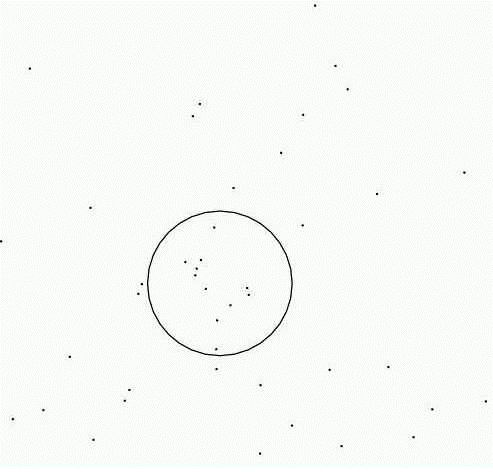Circle and Points
| Time Limit: 5000MS | Memory Limit: 30000K | |
| Total Submissions: 7327 | Accepted: 2651 | |
| Case Time Limit: 2000MS | ||
Description
You are given N points in the xy-plane. You have a circle of radius one and move it on the xy-plane, so as to enclose as many of the points as possible. Find how many points can be simultaneously enclosed at the maximum. A point is considered enclosed by a circle when it is inside or on the circle.

Fig 1. Circle and Points

Fig 1. Circle and Points
Input
The
input consists of a series of data sets, followed by a single line only
containing a single character '0', which indicates the end of the input.
Each data set begins with a line containing an integer N, which
indicates the number of points in the data set. It is followed by N
lines describing the coordinates of the points. Each of the N lines has
two decimal fractions X and Y, describing the x- and y-coordinates of a
point, respectively. They are given with five digits after the decimal
point.
You may assume 1 <= N <= 300, 0.0 <= X <= 10.0, and 0.0 <= Y <= 10.0. No two points are closer than 0.0001. No two points in a data set are approximately at a distance of 2.0. More precisely, for any two points in a data set, the distance d between the two never satisfies 1.9999 <= d <= 2.0001. Finally, no three points in a data set are simultaneously very close to a single circle of radius one. More precisely, let P1, P2, and P3 be any three points in a data set, and d1, d2, and d3 the distances from an arbitrarily selected point in the xy-plane to each of them respectively. Then it never simultaneously holds that 0.9999 <= di <= 1.0001 (i = 1, 2, 3).
You may assume 1 <= N <= 300, 0.0 <= X <= 10.0, and 0.0 <= Y <= 10.0. No two points are closer than 0.0001. No two points in a data set are approximately at a distance of 2.0. More precisely, for any two points in a data set, the distance d between the two never satisfies 1.9999 <= d <= 2.0001. Finally, no three points in a data set are simultaneously very close to a single circle of radius one. More precisely, let P1, P2, and P3 be any three points in a data set, and d1, d2, and d3 the distances from an arbitrarily selected point in the xy-plane to each of them respectively. Then it never simultaneously holds that 0.9999 <= di <= 1.0001 (i = 1, 2, 3).
Output
For
each data set, print a single line containing the maximum number of
points in the data set that can be simultaneously enclosed by a circle
of radius one. No other characters including leading and trailing spaces
should be printed.
Sample Input
3 6.47634 7.69628 5.16828 4.79915 6.69533 6.20378 6 7.15296 4.08328 6.50827 2.69466 5.91219 3.86661 5.29853 4.16097 6.10838 3.46039 6.34060 2.41599 8 7.90650 4.01746 4.10998 4.18354 4.67289 4.01887 6.33885 4.28388 4.98106 3.82728 5.12379 5.16473 7.84664 4.67693 4.02776 3.87990 20 6.65128 5.47490 6.42743 6.26189 6.35864 4.61611 6.59020 4.54228 4.43967 5.70059 4.38226 5.70536 5.50755 6.18163 7.41971 6.13668 6.71936 3.04496 5.61832 4.23857 5.99424 4.29328 5.60961 4.32998 6.82242 5.79683 5.44693 3.82724 6.70906 3.65736 7.89087 5.68000 6.23300 4.59530 5.92401 4.92329 6.24168 3.81389 6.22671 3.62210 0
Sample Output
2 5 5 11
代码转自,不想去弄了。。以后就做模板用好了 http://www.cnblogs.com/-sunshine/archive/2012/10/11/2719859.html
贴个模板:
#include<stdio.h> #include<iostream> #include<string.h> #include <stdlib.h> #include<math.h> #include<algorithm> using namespace std; const int N = 300; struct Point{ double x,y; }p[N]; struct Node{ double angle; bool in; }arc[180000]; int n,cnt; double R; double dist(Point p1,Point p2){ return sqrt((p1.x-p2.x)*(p1.x-p2.x)+(p1.y-p2.y)*(p1.y-p2.y)); } bool cmp(Node n1,Node n2){ return n1.angle!=n2.angle?n1.angle<n2.angle:n1.in>n2.in; } void MaxCircleCover(){ int ans=1; for(int i=0;i<n;i++){ int cnt=0; for(int j=0;j<n;j++){ if(i==j) continue; if(dist(p[i],p[j])>R*2) continue; double angle=atan2(p[i].y-p[j].y,p[i].x-p[j].x); double phi=acos(dist(p[i],p[j])/2); arc[cnt].angle=angle-phi;arc[cnt++].in=true; arc[cnt].angle=angle+phi;arc[cnt++].in=false; } sort(arc,arc+cnt,cmp); int tmp=1; for(int i=0;i<cnt;i++){ if(arc[i].in) tmp++; else tmp--; ans=max(ans,tmp); } } printf("%d ",ans); } int main(){ while(scanf("%d",&n)!=EOF&&n){ //scanf("%lf",&R); R = 1; //此题R为1 for(int i=0;i<n;i++) scanf("%lf%lf",&p[i].x,&p[i].y); MaxCircleCover(); } return 0; }